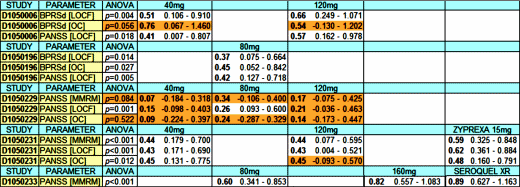… Later I learned that the FDA is a pretty nice bunch, and if you can’t find what you’re looking for posted online, they’ll send it to you with a simple Freedom of Information Act request made online – charging a nominal fee only if you’re a frequent flyer or your request is hard to gather.
Effect Sizes [Cohen’s d]

Note: The highlighted values are not statistically significant. There are two significance tests in the table. The one way ANOVA tests all values. If it is insignificant, testing the individual groups doesn’t matter. It says that there’s no significance to be found. This was skipped in the FDA Report. If the ANOVA reveals significance, then the pairwise comparisons can be used to locate the significance. If the lower limit of the 95% Confidence Interval is less than zero, it is insignificant.
WHY ALL THIS PREOCCUPATION WITH LURASIDONE? THE FDA?
In the past, I’ve gone back and looked at the clinical trials and the FDA reports, but the real time for looking had really long passed. By the time I looked, the drugs were blockbusters and the patents were close to running out or already expired. So I made a resolution that when some new drug was approved, I was going to start looking early. You can’t really close the barn door after the cows have already escaped was my theory. So I wanted to follow the teachings of preventive medicine – early detection. Vet the studies as soon as you get wind that a new drug has appeared. Once the drug is launched and in heavy use, It’s too late to do much except whine, at least that was my idea. Then came the news that PHARMA was abandoning CNS drug development, which was fine with me. We needed time for things like data transparency, AllTrials, RIAT, EMA data release [the reform movements] to get established. So when me-too drugs like Vybriid® and Latuda® came along, I didn’t think they would go anywhere. But that was naive, and when I saw that next Latuda® approval for Bipolar Depression [or both…], I revived my early detection theory.
So I made my little table up there with the Schizophrenia data and sat back, smug in the knowledge that around the corner was the FOIA FDA report on the Bipolar Depression approval. Even after reading Sandra Steingard’s MIA blog [A New Silver Bullet? The Lurasidone Story] about the Sunovion reps hanging around and seeing all the ads, I still felt like I was ahead of the curve. That was Monday.
A NAP INTERRUPTED:
Tuesday, after a long morning working in the clinic, I was awakened from a recovery nap by a mid-afternoon phone call. It was the FDA calling. The lady on the phone told me she’d seen I’d made other requests, but they were for "older drugs" [I wasn’t liking how this was sounding so far]. She said it was different for recent approvals. I didn’t follow all of what she was saying, but she seemed to be trying to dissuade me from pursuing my request. She said it had to go through several processes one of which was "disclosures" and there might be a charge. Did I still want to stay in the queue? By this time I was awake enough to say, "Sure. How long is the usual wait?" She said "18 to 24 months. You know, we get over 3000 requests every year." long pause. I said "Okay" [having given up with taking out my frustrations with big systems on small bureaucrats long ago]. But when I was fully awake and thought about it, I think I learned something, and have to revise my theory. My now fading enthusiasm for the FDA had been based on experiences where what I was requesting was old hat, and just required copying a disk from somebody else’s previous request. The fantasy that I could get the information on a recent approval in a timely fashion was naive. This drug is going to be well down the line in it’s patent life before I ever see that report, just like before. The previous reports I’ve gotten have had very little redacted, but there’s still apparently government processes that comes before release, some bureaucratic government processes measured in years.
It brings up a problem that’s general to Data Transparency. We’re not looking at the data [if we can even get it] with a magnifying glass. We’re seeing it through a telescope focused somewhere in the past. I thought about an article I read recently in the BMJ [Why did it take 19 months to retrieve clinical trial data from a non-profit organisation?], the travails of the investigators like Peter Doshi and Thomas Jefferson trying to get the Tamiflu studies, the bruhaha over getting trial data from the European Medicines Agency, the years it has taken [and is still taking] to get the data from Paxil Study 329, the disappointing clinicaltrials.gov results database [even when they’re reported much later], etc. While some of the problem can be obstruction by the pharmaceutical industry, there’s another bureaucratic factor that may be a just as big a hurdle. And what’s happening here appears to be its general form – preparing the data, checking for "disclosures."
A REAL TIME PROBLEM:
The essence of the problem involves time. What has happened in the past is that once a drug is approved, the sugar coated articles in the journals are rapidly disseminated by drugs reps to practitioners. For example, the lead-off Lurasidone Schizophrenia article in the American Journal of Psychiatry failed to mention the heavy use of Benzodiazepines in the trial, the larger effect sizes with Olanzapine, or the relatively poor showing at the US sites among other things. So the long lag times in being able to see more of the back story essentially allow the drug to be launched unchallenged by any independent vetting of the studies.
And what is it in the report to the FDA or the anonymized patient data that needs to be gone over to check for "disclosures"? Why not ask the pharmaceutical applicants not to put any secrets in their reports or data in the first place. We heard Neal Parker, a lawyer for AbbeVie [a deal-breaker?…], tell us there was commercially sensitive data, that revealing it would have them lose their competative edge – to which I would say, "Don’t put such things in your report." Good old boy negotiations have no place in drug approval anyway. I can think of no real reason that data submitted to the FDA, or the EMA, or even the raw data prior to analysis should contain secrets that have to be removed. Similarly, the pharmaceutical companies currently setting up expert panels to approve access are claiming that they need time to prepare the data. I don’t think Data Transparency means "prepared data." In fact, it means the opposite. The sugar coated published paper is already "prepared data." Data Transparency means "unprepared data."
 THE POINT: If a journal article is a proxy for a data-set generated by a Clinical Trial [which it is][see proxies…], there’s no rational reason that the data should lag behind the publication. If the FDA or EMA Approvals are suggesting that a drug is safe and efficacious, there’s no reason that practitioners and researchers shouldn’t be able to see how that conclusion was reached. And based on past behavior, once the drug is launched, there’s an inertia that carries it forward. If there are questions about the drug, they need to be on the table early on. Particularly in psychiatry, there have been a number of blockbusters with some real problems that would’ve been apparent early on had there been an early review of the raw data.
THE POINT: If a journal article is a proxy for a data-set generated by a Clinical Trial [which it is][see proxies…], there’s no rational reason that the data should lag behind the publication. If the FDA or EMA Approvals are suggesting that a drug is safe and efficacious, there’s no reason that practitioners and researchers shouldn’t be able to see how that conclusion was reached. And based on past behavior, once the drug is launched, there’s an inertia that carries it forward. If there are questions about the drug, they need to be on the table early on. Particularly in psychiatry, there have been a number of blockbusters with some real problems that would’ve been apparent early on had there been an early review of the raw data.
The old sales tool of delay and divert. Sure you can have the information, let me get that for you. Sorry, there has been a catch in the system, the computer is down, and of course I will respect you in the morning.
Steve Lucas
Sandy Steingard’s article is brilliant — as are yours, Dr. Mickey.
I would go through my Congresscritter to get that Latuda info from the FDA. It’s all on disks already. That’s how they pass it from reviewer to reviewer.
This link may be of interest as it highlights the drug industry’s payments to the FDA for drug approval.
http://www.fda.gov/forindustry/userfees/prescriptiondruguserfee/default.htm
When you introduce a payment into a system you change the dynamics of the relationship.
Can a doctor be bought for a coffee mug? No.
Will a doctor speak to a person who gives them a coffee mug? Yes.
Will the FDA protect those who pay fees for approval? I would say yes.
Steve Lucas
As long as the drug companies do the testing, this is how it’s going to be.
Wiley,
see http://pharmagossip.blogspot.com/2014/02/pharma-companies-shouldn-conduct.html
The question I have about bureaucratic snafus is, Are they the result of plain old incompetence, a poor system, or the rules that dictate the poor system? And if it’s the rules, who makes those rules? More precisely, who pays for the lobbying that gets those rules made?
Psych Practice-
Was the last question tongue-in-cheek? Steve Lucas’ link above addresses some of the problem. Ironically, as I understand the history, this payment system was intended to move drugs along at a faster pace. This was pushed through by the “HIV” lobby at a time when people were dying. In the 90’s we saw the unintended consequences of that change. The pharma lobby is so wealthy and huge today and the leaders of our profession just back them up.
Thanks for that moment of Zen, Mickey. About: blank is a wonderfully simple koan. Now I’m gonna look for it on pharmagossip. I still need doses of critical psychiatry now and then, thanks for the lead.